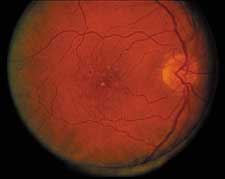Laser treatment of drusen aims for improved visual function
In clinical trials, laser treatment of drusen resulted in reduction and long-term resolution.
KOLOA, Hawaii – Several clinical trials in the United States and abroad have shown that drusen in eyes with age-related macular degeneration (AMD) can resolve by more than half following laser photocoagulation. Allen C. Ho, MD, reported on the status of laser treatment of drusen for AMD here at Retina 2001, presented with Hawaii 2001, the Royal Hawaiian Eye Meeting, sponsored by Ocular Surgery News in conjunction with the New England Eye Center.
“There are several pilot clinical trials in the United States, Spain, Sweden, England and elsewhere investigating the potential beneficial effects of light laser photocoagulation in eyes with high risk drusen and early AMD,” Dr. Ho said. “Many patients resolve their drusen, with significant reduction characterized by greater than 50%. So laser does work, but the reduction of drusen is not our object, it is really improving the long-term outlook and visual function.”
In 1994 the Choroidal Neovascularization Prevention Research Group, led by Drs. Stuart Fine, Maureen Maguire and Allen Ho, initiated a large pilot study — the Choroidal Neovascularization Prevention Trial (CNVPT) — to determine the safety and potential efficacy of light laser treatment in two groups of patients with AMD: the Bilateral Drusen Study, where both eyes of a patient demonstrate high risk drusen and the Fellow Eye Study, where one eye of a patient with AMD demonstrates large drusen and the other eye had current or prior evidence of exudative AMD. This large-scale pilot study enrolled 432 eyes in the Bilateral Drusen Study and the Fellow Eye Study.
Laser to drusen rationale
|
|
Dr. Ho described the rationale for laser to drusen as such: Drusen that are greater than 63 µm are a clinical sign of diffuse thickening of Bruch’s membrane, and are a known risk factor for the development of late complications of AMD, such as geographic atrophy, choroidal neovascularization (CNV) and subsequent central vision loss. Laser-induced drusen reduction may thus decrease the risk of geographic atrophy and CNV.
“The mechanism of laser-induced drusen reduction remains unknown, but has been hypothesized to be related to a stimulation of cellular phagocytosis from choroidal cells or possibly by promoting the egress of drusen material through a hydrophobic Bruch’s membrane,” Dr. Ho said
Two large-scale studies are exploring this concept. The Complications of AMD Prevention Trial (CAPT) uses low-intensity laser treatment in eyes of patients with bilateral drusen. The Prophylactic Treatment of AMD Study Group is investigating the potential effects of subthreshold, clinically invisible, diode laser photocoagulation treatment in eyes with iris drusen. This group found a higher incidence of CNV in eyes treated with threshold laser lesions compared to eyes receiving subthreshold laser lesions using the diode laser. This group is enrolling patients with unilateral and bilateral drusen.
To participate in the studies, patients had to be 50 years or older and willing to participate in follow-up for up to 5 years. Study eyes must have 10 or more large drusen of greater than 63 µm within 3,000 µm of the foveal center, have visual acuity of 20/40 or better, have no evidence of geographic atrophy or exudative AMD and have no other evidence of progressive ocular disease.
CNV development in CNVPT
“Although there was an initial imbalance in the event of new vessel development between eyes receiving prophylactic laser treatment and eyes randomly assigned to observation, treated eyes had not shown an adverse effect on visual acuity compared to observed eyes. Development of CNV was equivalent in laser treated and observed eyes of the Fellow Eye Study at 30 months,” Dr. Ho said.
No significant differences in the development of CNV were observed within the Bilateral Drusen Study arm of the CNVPT.
The primary outcomes measurement is change in visual acuity. The secondary outcomes will be the incidence of CNV, pigment epithelial detachment, geographic atrophy, contrast threshold and critical print size for reading.
The PTAMDS halted recruitment of patients with unilateral drusen in 2000 due to a higher rate of CNV in laser-treated eyes, though there were no differences in visual acuity.
“As you know from following your patients over time, drusen in eyes have a natural history of their own that goes to isolated drusen, to confluence and to neurosensory retina and focal hyper-pigmentation. I think some of those eyes with pigment are really harboring occult CNV that is even occult to our fluorescein and/or ICG angiography,” Dr. Ho said.
Eventually the drusen begin to resolve on their own, leaving areas of frank geographic atrophy.
“Maybe if we can abort the cycle, like we do in proliferative diabetic retinopathy, where pan-retinal laser treatment by passes the scarring and distortion of the macula and allows regression of the neovascularization, we can effect a change in this disease,” Dr. Ho said
For Your Information:
- Allen Ho, MD, can be reached at Wills Eye Hospital, Retina Services, 900 Walnut St., Philadelphia, PA 19107; (215) 928-3300; fax: (215) 238-0804.


